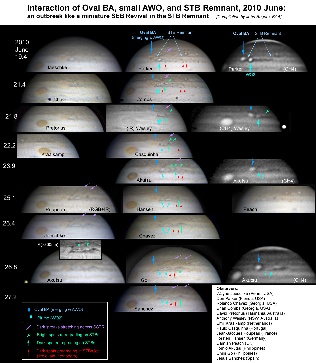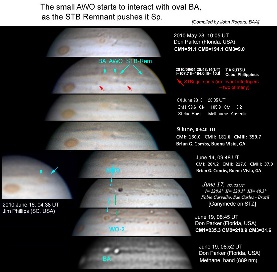

[4] A triple collision of long lived circulations in the S. Temperate domain (July 17th, 2010.)
Jupiter
in 2010: BAA Jupiter Section bulletin (2010 June 28 & July 17):
A
triple collision of long-lived circulations in the S. Temperate domain:
The
collision of three long-lived features in the S. Temperate domain has led to the
rapid merger of the two anticyclonic circulations (oval BA and the white oval
following it), and unexpected, never-before-observed fireworks in the cyclonic
circulation (the STB Remnant). These
events seem to be miniature versions of phenomena observed in the S. Tropical
domain. The merger may have been similar to the merger of the GRS and
LRS in 2008, while the outbreak in the STB Remnant is a miniature version of a
SEB Revival outbreak.
Introduction
Oval
BA formed by merger of earlier great white ovals in 2000.
A smaller anticyclonic white oval (AWO) is usually present shortly f. BA;
the present one probably dates from 2004, although it may have been replaced in
2008. The STB Remnant is a faint,
pale blue cyclonic circulation that also arose in 2004.
There
are always 2-4 large-scale circulating complexes in the S.Temp.region, each
consisting of one or more long-lived anticyclonic or cyclonic circulations. In 2003-04, these consisted of (1) oval BA plus a small AWO f.
it, with an associated STB segment; and (2) a dark cyclonic segment of STB.
Complex (2) gradually drifted up to the f. side of oval BA and became part of
complex (1); at the same time, some new spots appeared on the other side of the
planet, which developed into the present STB Remnant.
These events have been repeated this year: the STB Remnant in turn has
drifted up to the f. side of oval BA, triggering the events described in this
bulletin, while a new dark segment of STB has become prominent on the other side
of the planet.
Observational
results and discussion, 2010 June
[see
image compilations
below:]
The
dark cyclonic spot which had separated oval BA from the AWO had shrunk
considerably in 2009, and its last vestige disappeared in 2010 May. At
that time, the p. edge of the STB Remnant was already in contact with the AWO.
The AWO’s shape seemed to be unstable, while dark streaks were beginning to
outline the perimeter of the STB Remnant. As
Chris Go noted, on May 31 the AWO was moving closer to BA, and a merger seemed
imminent. After further interactions in early June with the STB Remnant
continuing to intrude dark blue-grey material right up to oval BA, the AWO was
in contact with BA on June 16 (Jim Phillips: image not included) , and merger
was clearly under way on June 17. In Fabio Carvalho’s image on June 17, the
AWO was swinging round or intruding into the S side of oval BA. When next
recorded, in Don Parker’s extraordinary images on June 19, much had happened
very quickly.
The
merger with oval BA:
On
June 19 the small AWO could no longer be seen, but oval BA seemed to have an
unusually prominent whitish annulus around its orange core. Although such an
annulus could be exaggerated by the image processing, it was shown in Wayne
Jaeschke’s image as well as Don Parker’s, so it may well be a sign of the
merger. But on June 21 and 22, oval BA was distorted, with a reddish
‘satellite’ on the Np. side; and in A.Wesley’s methane image it appeared
tilted. After that, there is no definite asymmetry in oval BA, but its contrast
is rather low and its outline not sharply defined.
Interpretation:
In
its initial contact with oval BA, the AWO seemed to be pushed by the STB
Remnant, and no doubt pulled by the anticlockwise circulation of oval BA. But
the subsequent images do not show any obvious orbital motion.
I suggest that the merger did not resemble the mergers of equal-sized
large ovals, as described by A. Sanchez-Lavega’s group and by us. Instead, it
was a merger of a small oval with a large one, of which we have observed several
in recent years. The large-scale exemplar of these was the merger of the GRS
with a LRS in 2008 [see reports on our web site]. The present merger can be
interpreted in exactly the same way as the GRS-LRS merger. The AWO started to be
dragged anticlockwise around oval BA on June 17; on June 19 it had been
stretched into an unresolved loop around oval BA (the ‘annulus’), but a
major part of it then emerged p. oval BA (the ‘satellite’), and lingered for
a few days on its p. side before being pulled back in for a final merger on June
23-26.
Streaks
stretching across S.S.Temp. region:
Also on June 19, new dark and bright streaks were visible on the S edge of oval BA: apparently disturbance created by the ongoing merger. Remarkably, the dark streak stretched out in the Sf. direction over the next week and was paralleled by a second such streak; the two oblique streaks spanned the whole width of the S.S.Temp.domain.
Interpretation:
The
orientation suggests that the dark streak was entrained by a retrograding jet on
the SSTBs, although this has never been recorded as a strong jet, and would not
be expected to operate across such a broad range in latitude.
Outbreak
in the STB Remnant:
This
remarkable outbreak, named WO2, was first recorded as a tiny bright spot on June
17, and attracted attention on June 19 when Don Parker’s images showed it to
be extremely bright in visible light, UV, and methane band.
(It was confirmed in lower-resolution RGB images at about the same time
by Wayne Jaeschke, Jim Phillips, and Michael Phillips.)
It
seemed likely that WO2 was an erupting plume similar to the source of an SEB
Revival. Indeed, over the following week it has developed just like such a
source. Features indicated in the attached set of images are:
--The
plume at the source: In visible-light images, it has remained present but often
multiple; it has budded off several small bright spots on STBs and also extended
into a series of bright streaks within the STB Remnant. In methane images, it
was still somewhat methane-bright up to June 26, but progressively much fainter
and more extended, as the proliferating streaks were also methane-bright.
--Bright
spots on STBs: Several of these
appeared adjacent to the source plume and probably retrograded on the S edge of
the STB Remnant, i.e. in the STBs jet, a rarely observed retrograding jet. At
least the first spot was methane-bright (Wesley, June 21). By June 23 there was
a chain of 3 such spots on STBs, but they seem to have dissipated before passing
the f. end of the STB Remnant.
--Dark
spot on STBs: Trailing behind the
first of the bright spots was a small, very dark bluish spot, which became more
distinct by June 25, definitely retrograding, with DL2 ~ +3.7 deg/day,
decreasing to ~+2.4 deg/day on June 26-27 as it neared the f. end of the STB
Remnant.
(Dr
Guy Stringfellow & Dr Glenn Orton have methane-band images from the NASA-IRTF
which will complement our data.)
Interpretation:
Nothing
so methane-bright as WO2 had ever been recorded in a cyclonic belt.
However, plumes in the SEB or NEB can be modestly methane-bright, most
notably a new plume seen at the source of the SEB Revival in HST images on 2007
June 5, which likewise was bright in methane and UV as well as visible. It
seemed likely that WO2 was an erupting plume similar to the source of an SEB
Revival. Indeed it has behaved in just this way, on a miniature scale, with new
bright spots repeatedly appearing at and around the original source, and bright
and dark spots being emitted onto the adjacent retrograding jet.
The
speed measured for the retrograding dark spot is extraordinarily high for this
jet, which attains only ~+1 deg/day in spacecraft data, perhaps because it is
faster within the STB Remnant.
The
eruption appeared to be triggered by the adjacent collision of anticyclonic
ovals, as it started on the day they collided.
However it is also possible that such an eruption would have happened
anyway as the STB Remnant had just contacted oval BA. It was likely that the STB
Remnant (thought to be a closed cyclonic circulation) would transform into a
turbulent cyclonic belt segment forming the usual ‘wake’ f. oval BA.
Similar
eruptions have been recorded in cyclonic circulations, though without
methane-band imagery. In the SEB, vigorous outbreaks have been shown to arise
from within cyclonic barges (1979, 2007, possibly others). In the SSTB, Voyager
2 images showed that a cyclonic white oval converted to a chaotic filamentary
region via such an eruption. It is possible that such methane-bright eruptions
in cyclonic belts are not very uncommon, but they only remain *very*
methane-bright for a day or so, and Don Parker was lucky to obtain a hi-res
methane image at just the right time.
Congratulations
to all the observers for achieving such a thorough hi-res record of this
exciting event. Names are listed on
the attached image sets – and thanks also to those whose images are not
included, but were nevertheless welcome .
Further developments up to July 25th:
Oval
BA is now well-defined, and so is its internal orange annulus.
The
former STB Remnant is now established as a very turbulent sector of STB f. oval
BA.
Many
tiny white spots and streaks are still appearing within it, too complicated to
track even over 10 hours.
Two
very dark blue-grey spots have become distinct at the f. end of this complex.
The first such spot retrograded with mean DL2 = +100 (+/-10) deg/mth,
June 21-28, then it reached the f. end of the former STB Remnant and halted in
L2. Another similar spot developed p. it on July 5, and both remained with DL2 =
+1 deg/mth, latitude [from Christophe Pellier] 33 deg.S, typical of these dark
spots cast off from the Sf. end of STB sectors.
In
the methane band, oval BA is bright as usual but the sector f. it has resumed
its normal dark aspect.
Also:
Blue-grey
dark spots in mid-SEB mark the Np. edges of last year’s barges, now very
faint.
Just
N of the GRS, a bright white spot erupted on July 2 (pointed out by T. Mishina),
which is weakly visible in methane images, like a similar spot in 2009.
P. it is the blue triangle; f. it, a new blue-grey line has extended
around the Red Spot Hollow, probably from the white spot.
Best
wishes,
John
Rogers
_________________________________
John
H. Rogers
Jupiter
Section Director,
British
Astronomical Association
http://www.britastro.org/jupiter/